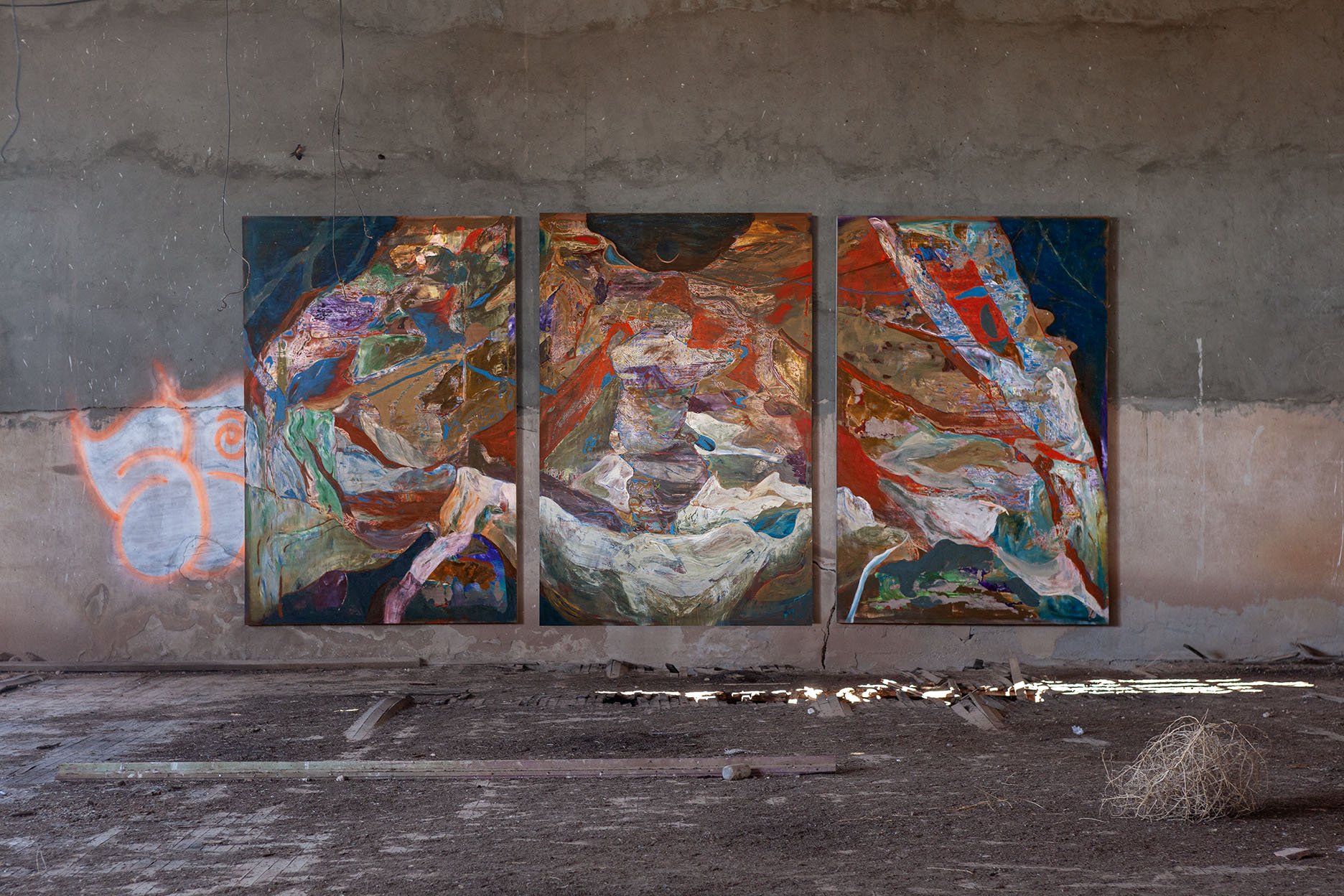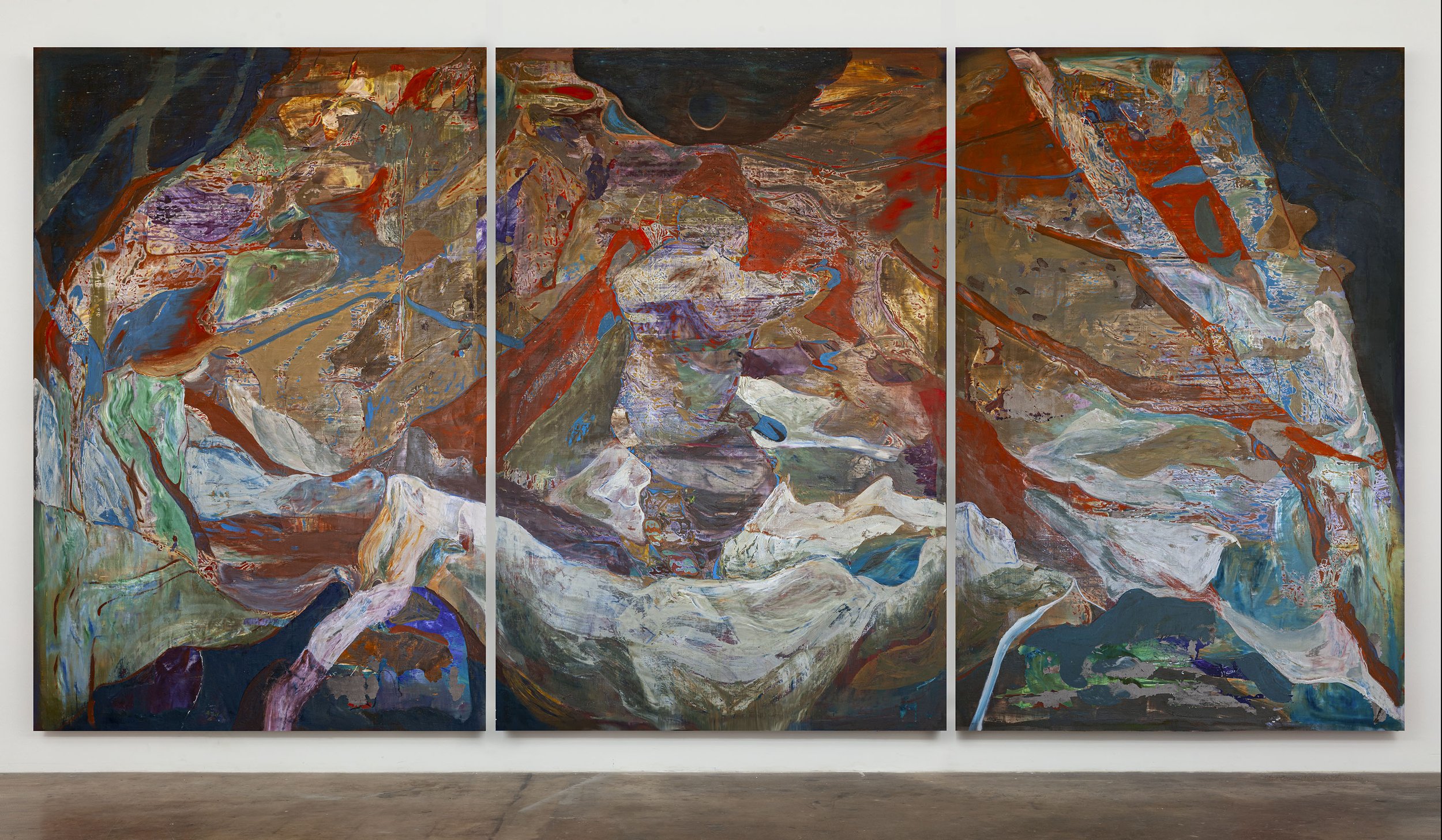The Hermit
‘The Hermit’ Installed in Abandon School in Cedarvale New Mexico
Most paintings in the Nihil project are created by referencing drawings made over the span of a day or two along the Nihil route in New Mexico, where we live. This is true, too, of the triptych “The Hermit,” which was made from drawings along the Rio Grande near the village of San Acacia and in the Sandia Wilderness near our own village of Placitas on January 29th and 30th, 2024. Earlier layers in the painting were made from a location along the river where I sat for meditation. The figure appearing in the center arrived in the final two layers from drawings which showed my daughter playing in her winter coat, hat and mittens inside of an abandoned shelter we call a “hermit’s hut” made of branches, leaves, and pine needles in the nearby forest. Working in this way, figures tend to lose specificity, or gain eccentric features, as portions of each layer are lost and changed in the scraping and subtraction process. Most of my paintings work in this way. On one hand, it is simply a painting about my daughter playing in the woods, and it would be enough to think of it as such. On the other, the paintings tend to open onto other unexpected vistas.
Return to the site of ‘The Hermit’ | June 2024
Though I can never say what the work is about, I do make observations in the moment and over time, which I might offer. One wouldn’t guess the figure was made by observing a three-year-old girl. The piece is so enormous that the figure is about as large as an adult viewer. We don’t know any of the things about the figure that we use to identify or mark ourselves and each other in life. We can’t even identify a time period in which the figure might be situated. Even the environment appears as if alternately a space or a kind of physical presence in its own right, perhaps animal in nature, and almost symmetrical in form. This happened largely by chance; some of the earlier layers show through with gestures and marks one might use to indicate things like rocks, cliffs, tree branches and grasses.
The palette of the work serves the painting as an object, but, again, doesn’t tell us exactly what kind of an environment or landscape this is in. This is because the palette also happens more or less by chance, through a system of color as designated by the Nihil tenets. Because of the constraints and elements of chance involved in the process, many small revelations or epiphanies will occur over the course of making a painting, which often feel synchronous. I tend to believe that when the conscious mind is constrained to procedures that produce chance results, the unconscious takes over.
At this stage, I notice a few more things. The loss of naturalistic human characteristics of the figure through this process renders it more archetypal than actual. I tend to read the archetypes that emerge in my work as a nascent second language bubbling up to the surface in a kind of “working out” of the unconscious. To call the painting “The Hermit,” was simply the first word that came to mind, and probably because we had given the shelter in the woods the nickname “hermit’s hut.” It’s also funny to refer to the figure of my daughter as a hermit. But although I was lighthearted in my approach, there is, for me, a deeper truth registering from under our private humor.
‘The Hermit’ Detail
I often half-jokingly refer to myself as a hermit, having removed myself from the big cities six years ago to live in an unknown New Mexico village where I spend most mornings wandering in the mountains likes some kind of hillbilly prophet. I struggle in contemporary culture broadly, and find extended periods in cities a loud and claustrophobic affair. Political arguments and gestures of all persuasions feel less and less believable. In some ways, “The Hermit” is a painting made by a hermit, which in turn, makes it something of a self-portrait.
On late reflection, a discrete irony opens up in the work. There’s no real reason to have made it as large as I did except that I will soon install it in an abandoned gymnasium, which has massive walls. The work is site specific in a sense, to a site that no one will ever see in person. It hints at the tradition of history painting, but depicts no particular historical narrative. In this way, it’s childlike. Perhaps the painting is one way the world might appear before we’re told how we’re supposed to see it. Still mysterious. Still new. Still open-ended.
We look at the world once in childhood.
The rest is memory.
-Louise Glück, from the poem “Nostos”
‘The Hermit” | Mixed Media on Linen | 120 x 240 inches | 2024



